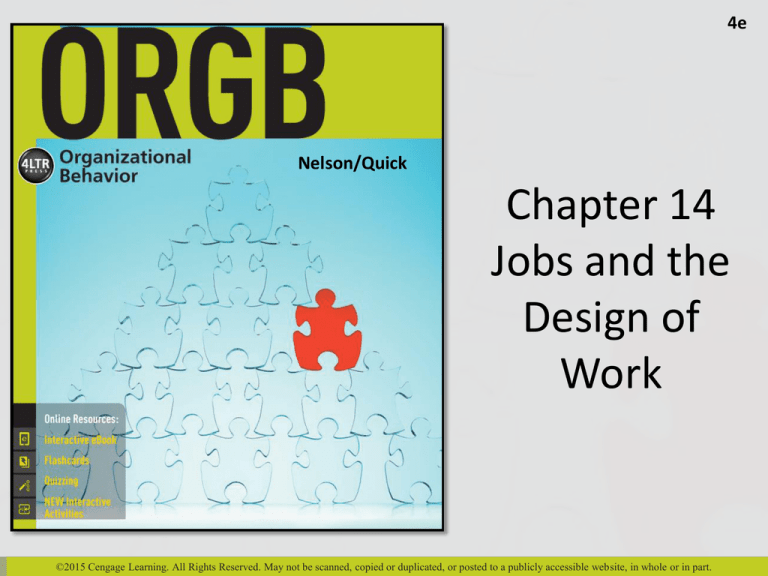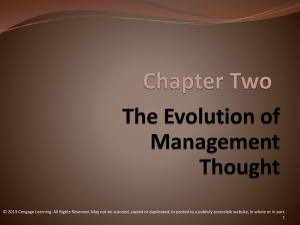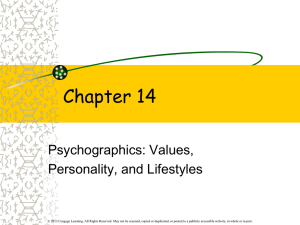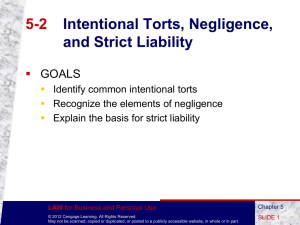
4e
Nelson/Quick
Chapter 14
Jobs and the
Design of
Work
©2015 Cengage Learning. All Rights Reserved. May not be scanned, copied or duplicated, or posted to a publicly accessible website, in whole or in part.
Learning Outcomes
Differentiate between job and work
Discuss the traditional approaches to job design
Identify and describe alternative approaches to job
design
Identify and describe contemporary issues facing
organizations in the design of work
©2015 Cengage Learning. All Rights Reserved. May not be scanned, copied or duplicated, or posted to a publicly accessible website, in whole or in part.
2
Learning Outcome
Differentiate between job and work
©2015 Cengage Learning. All Rights Reserved. May not be scanned, copied or duplicated, or posted to a publicly accessible website, in whole or in part.
3
Job
Set of specified work and task activities that engage
an individual in an organization
Not the same as organizational position, career, and
work
©2015 Cengage Learning. All Rights Reserved. May not be scanned, copied or duplicated, or posted to a publicly accessible website, in whole or in part.
4
Work
Mental or physical activity that has productive
results
Meaning of work
Way a person interprets and understands the value
of work as part of life
©2015 Cengage Learning. All Rights Reserved. May not be scanned, copied or duplicated, or posted to a publicly accessible website, in whole or in part.
5
Six Patterns of Work
Pattern A
Pattern B
Value comes from performance and for which a person is
accountable
Provides a person with positive personal affect and identity
Pattern C
Activity from which profit accrues to others by its
performance and can be done in various settings
Pattern D
Physical activity directed by others and performed in a
working place
Pattern E
Pattern F
Physically and mentally strenuous activity
Activity constrained to specific time periods that does not
bring positive affect through its performance
©2015 Cengage Learning. All Rights Reserved. May not be scanned, copied or duplicated, or posted to a publicly accessible website, in whole or in part.
6
Learning Outcome
Discuss the traditional approaches to job
design
©2015 Cengage Learning. All Rights Reserved. May not be scanned, copied or duplicated, or posted to a publicly accessible website, in whole or in part.
7
Traditional Approaches to Job
Design
Scientific
Management
Job
Characteristics
Theory
Approaches
Job
Enrichment
Job Enlargement/
Job Rotation
©2015 Cengage Learning. All Rights Reserved. May not be scanned, copied or duplicated, or posted to a publicly accessible website, in whole or in part.
8
Scientific Management
Emphasizes work simplification
Work simplification: Standardization and the narrow,
explicit specification of task activities for workers
Jobs have limited number of scientifically-designed
tasks
Elements focus on the efficient use of labor to the
economic benefit of the firm
©2015 Cengage Learning. All Rights Reserved. May not be scanned, copied or duplicated, or posted to a publicly accessible website, in whole or in part.
9
Work Simplification
Pros
Cons
• Allows workers of diverse
backgrounds to work
together
• Leads to production
efficiency and to higher
profit
• Undervalues the human
capacity for thought and
ingenuity
• Dehumanizes the work
force by treating labor as
a means of production
10
Job Enlargement
Increases the number of activities in a job to
overcome the boredom of overspecialized work
Variations
Job rotation: Exposes a worker to a variety of
specialized job tasks over time
Cross-training: Workers are trained in different
specialized tasks or activities
©2015 Cengage Learning. All Rights Reserved. May not be scanned, copied or duplicated, or posted to a publicly accessible website, in whole or in part.
11
Job Enrichment
Designing or redesigning a job by incorporating
motivational factors into it
Increases the amount of job responsibility through
vertical loading
Recommends increasing the recognition,
responsibility, and opportunity for achievement
©2015 Cengage Learning. All Rights Reserved. May not be scanned, copied or duplicated, or posted to a publicly accessible website, in whole or in part.
12
Job Characteristics Theory
Emphasizes the interaction between the individual
and specific attributes of the job
Job Diagnostic Survey (JDS): Measures the
elements in the Job Characteristics Model
Motivating Potential Score (MPS) - Indicates a job’s
potential for motivating incumbents
©2015 Cengage Learning. All Rights Reserved. May not be scanned, copied or duplicated, or posted to a publicly accessible website, in whole or in part.
13
Figure 14.1 - Job Characteristics Model
SOURCE: J. R. Hackman and G. R. Oldham, “The Relationship Among Core Job Dimensions, the Critical Psychological States, and On-the-Job
Outcomes,” in The Job Diagnostic Survey: An Instrument for the Diagnosis of Jobs and the Evaluation of Job Redesign Projects (New Haven,
Conn.: Department of Administrative Services, Yale University, 1974). Reprinted by permission of Greg R. Oldham.
©2015 Cengage Learning. All Rights Reserved. May not be scanned, copied or duplicated, or posted to a publicly accessible website, in whole or in part.
14
Job Characteristics Model
Psychological states stimulated by the core job
dimensions
Experienced meaningfulness of the work
Experienced responsibility for work outcomes
Knowledge of results
©2015 Cengage Learning. All Rights Reserved. May not be scanned, copied or duplicated, or posted to a publicly accessible website, in whole or in part.
15
Job Characteristics Model
Implementing concepts used by JDS for job redesign
efforts
Combining tasks into larger jobs
Forming natural work teams to increase task identity
and task significance
Establishing relationships with customers
Loading jobs vertically with more responsibility
Opening feedback channels for the job incumbent
©2015 Cengage Learning. All Rights Reserved. May not be scanned, copied or duplicated, or posted to a publicly accessible website, in whole or in part.
16
Job Characteristics Inventory (JCI)
Measures core job characteristics
Considers structural and individual variables
affecting the core job characteristics and the
individual
Similarity with JDS - Person-job fit approach
JCI versus JDS
Variety scales have different effects on performance
Autonomy scales have different effects on employee
satisfaction
©2015 Cengage Learning. All Rights Reserved. May not be scanned, copied or duplicated, or posted to a publicly accessible website, in whole or in part.
17
Engagement
Expression of oneself as one performs in work or
other roles
Psychological conditions affecting employees’
engagement in work
Meaningfulness
Safety
Availability
©2015 Cengage Learning. All Rights Reserved. May not be scanned, copied or duplicated, or posted to a publicly accessible website, in whole or in part.
18
Learning Outcome
Identify and describe alternative approaches
to job design
©2015 Cengage Learning. All Rights Reserved. May not be scanned, copied or duplicated, or posted to a publicly accessible website, in whole or in part.
19
Social Information Processing (SIP)
Model
Emphasizes the interpersonal aspects of work
design
Based on following premises
People provide cues we use to understand the work
environment
People help us judge what is important in our jobs
People tell us how they see our jobs
People’s positive and negative feedback helps us
understand our feelings about our jobs
©2015 Cengage Learning. All Rights Reserved. May not be scanned, copied or duplicated, or posted to a publicly accessible website, in whole or in part.
20
Ergonomics
Adapting work and working conditions to the
employee or worker
Develops an interdisciplinary framework for the
design of work
Allows the job designer to consider trade-offs and
alternatives among the approaches based on
desired outcomes
©2015 Cengage Learning. All Rights Reserved. May not be scanned, copied or duplicated, or posted to a publicly accessible website, in whole or in part.
21
Table 14.2 - Summary of Outcomes
from Various Job Design Approaches
SOURCE: Reprinted from Organizational Dynamics, 15(3), Michael A. Campion, Paul W. Thayer, “Job Design: Approaches, Outcomes, and Trade-Offs,” Winter/1987.
Copyright © 1987, with permission from Elsevier.
©2015 Cengage Learning. All Rights Reserved. May not be scanned, copied or duplicated, or posted to a publicly accessible website, in whole or in part.
22
Table 14.2 - Summary of Outcomes
from Various Job Design Approaches
SOURCE: Reprinted from Organizational Dynamics, 15(3), Michael A. Campion, Paul W. Thayer, “Job Design: Approaches, Outcomes, and Trade-Offs,” Winter/1987.
Copyright © 1987, with permission from Elsevier.
©2015 Cengage Learning. All Rights Reserved. May not be scanned, copied or duplicated, or posted to a publicly accessible website, in whole or in part.
23
International Perspectives on the
Design of Work
The Japanese approach
Emphasizes the strategic level
Encourages collective and cooperative working
arrangements
Emphasizes performance, accountability, and otheror self-directedness in defining work
©2015 Cengage Learning. All Rights Reserved. May not be scanned, copied or duplicated, or posted to a publicly accessible website, in whole or in part.
24
Lean Production and Sociotechnical
Systems
Lean production: Using committed employees with
ever expanding responsibilities to achieve:
Zero waste and 100 percent good product
On time delivery every time
Sociotechnical systems (STS): Giving equal attention
to technical and social considerations in job design
©2015 Cengage Learning. All Rights Reserved. May not be scanned, copied or duplicated, or posted to a publicly accessible website, in whole or in part.
25
Beyond the Book:
Lean Production to the Rescue
Manufacturing companies in the U.S. are turning to
lean production methods to stay profitable during
the recession.
The method involves producing only what is
ordered, reducing inventory and making each part
in an uninterrupted flow.
61% of manufacturers have adopted lean
production methods or plan to do so within the
next year.
©2015 Cengage Learning. All Rights Reserved. May not be scanned, copied or duplicated, or posted to a publicly accessible website, in whole or in part.
26
International Perspectives on the
Design of Work
The German approach
Traditional approach
Technocentric: Placing technology and engineering at
the center of job design decisions
Recent approach
Anthropocentric: Placing human considerations at the
center of job design decisions
©2015 Cengage Learning. All Rights Reserved. May not be scanned, copied or duplicated, or posted to a publicly accessible website, in whole or in part.
27
Figure 14.2 - Hierarchical Model of Criteria
for the Evaluation of Human Work
SOURCE: H. Luczak, “‘Good Work’ Design: An Ergonomic, Industrial Engineering Perspective,” in J. C. Quick, L. R. Murphy, and J. J. Hurrell, eds.,
Stress and Well-Being at Work (Washington, D.C.: American Psychological Association, 1997). Copyright ©1997 by the American Psychological
Association. Reprinted with permission.
©2015 Cengage Learning. All Rights Reserved. May not be scanned, copied or duplicated, or posted to a publicly accessible website, in whole or in part.
28
International Perspectives on the
Design of Work
The Scandinavian approach
Encourages a high degree of worker control
Encourages good social support systems for workers
©2015 Cengage Learning. All Rights Reserved. May not be scanned, copied or duplicated, or posted to a publicly accessible website, in whole or in part.
29
Table 14.3 - Adjusting Work Design
Parameters
©2015 Cengage Learning. All Rights Reserved. May not be scanned, copied or duplicated, or posted to a publicly accessible website, in whole or in part.
30
Learning Outcome
Identify and describe contemporary issues
facing organizations in the design of work
©2015 Cengage Learning. All Rights Reserved. May not be scanned, copied or duplicated, or posted to a publicly accessible website, in whole or in part.
31
Emerging Issues in the Design of
Work
Telecommuting
• Working in other locations separate from the company’s
main location
• Helps achieve a better fit between the needs of an
employee and the organization’s task demands
Alternative work patterns
• Job sharing: More than one person perform job
• Four-day workweek
• Flextime: Enables employees to set their own daily work
schedules
©2015 Cengage Learning. All Rights Reserved. May not be scanned, copied or duplicated, or posted to a publicly accessible website, in whole or in part.
32
Contemporary Issues in the Design
of Work
Virtual office: Mobile platform of computer, telecommunication,
and information technology and services
• Drawbacks
• Lack of social connection
• Technostress: Stress caused by new and advancing
technologies in the workplace
Skill development
• Technical and interpersonal skills are important
• Work design must recognize the importance of incumbent skills
and abilities to meet the demands of the work
©2015 Cengage Learning. All Rights Reserved. May not be scanned, copied or duplicated, or posted to a publicly accessible website, in whole or in part.
33
Beyond the Book:
The Work Design Questionnaire
The Work Design Questionnaire was created to fill
gaps in existing work-characteristics assessments
and integrate their data.
Results from the questionnaire found that both
motivational work characteristics and social support
played a strong role in predicting job satisfaction.
©2015 Cengage Learning. All Rights Reserved. May not be scanned, copied or duplicated, or posted to a publicly accessible website, in whole or in part.
34
Tyler Perry’s Daddy’s Little Girls
This chapter opened with a discussion of “job” and
“work.” Apply that discussion to the film sequence.
Include in your analysis the pattern of social interaction
between Monty and Julia.
Apply the job characteristics theory to the film
sequence. What is the level of each core job
characteristic for Monty’s job?
Estimate the levels of each critical psychological state
for Monty. Use Figure 14.1, “The Job Characteristics
Model,” as a guide. Use “low,” “middle,” or “high” for
your estimate.
©2015 Cengage Learning. All Rights Reserved. May not be scanned, copied or duplicated, or posted to a publicly accessible website, in whole or in part.
35
Camp Bow Wow
How do the tasks of managers and camp counselors
differ at Camp Bow Wow?
How does Camp Bow Wow utilize a form of job
rotation to keep camp counselors satisfied with
their jobs?
Using the job characteristics model, explain why the
employees of Camp Bow Wow love their jobs.
©2015 Cengage Learning. All Rights Reserved. May not be scanned, copied or duplicated, or posted to a publicly accessible website, in whole or in part.
36








